
|   |

|   |
 e-mail: sunilkothari1933@gmail.com Nakshatra Dance Festival Photos courtesy: NCPA November 9, 2018 The Nakshatra Dance Festival of NCPA (October 12 - 14, 2018) originated in 2009, and is held every October to feature innovative group choreographies. The festival featured two choreographic works on the first day - from Kolkata, Bimbavati Devi's Ghana Baari Barikhata in Manipuri and Vikram Iyengar's Shunya Se, a contemporary dance work based on Kathak. Bimbavati is the daughter of late Guru Bipin Singh and Kalavati Devi. Dance is in her blood. Brought up in a house where dance was taught to young dancers round the clock she imbibed the best from both her parents. Over the years she has proved to be not only a brilliant solo dancer but also as a choreographer. Ghana Baari Barikhata (Reflections in a raindrop) is her latest choreographic work that I saw in Dhaka on a large stage with large number of dancers and at Rabindra Sadan in Kolkata when she presented it as a part of concluding program of centenary celebrations of Guru Bipin Singh. 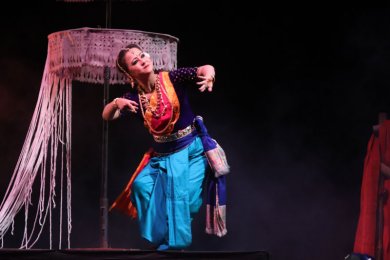
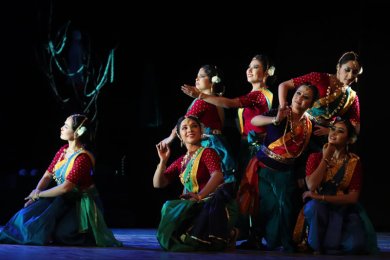
Each time on different venues, she made some changes to take advantage of the spacious stages. For the small Experimental Theatre stage in Mumbai, she re-choreographed some aspects. Since I could watch it from close quarters I enjoyed some sequences more. Drawing inspiration from Nata Sankeertana where the main song is recited, Bimbavati has woven the story of Radha and Krishna's love, keeping in view the effect monsoon creates on environment, birds, animals and lovers. She has woven effectively the state of mind of Radha as an abhisarika nayika on way to meet Lord Krishna. But before she goes, she practices how to walk on earth which is slippery and wet; she places thorns and tries to walk, and when she actually goes on abhisar, she encounters hurdles, serpent crossing the path, the sound of thunder, rains et al. The meeting with Krishna and sitting on swing, the Jhulan Jatra are imaginatively choreographed. The young handsome dancer playing Krishna and Bimbavati make a beauteous couple! The heartrending cries of gopis when Krishna leaves for Mathura, and gopis tying their hair to the wheels of chariot were very moving. Dashavatara prayer and karatali and male dancers performing with cymbals were executed as grand finale. The Manipuri dance technique in its multiple forms has been employed by Bimbavati for which she deserves compliments. 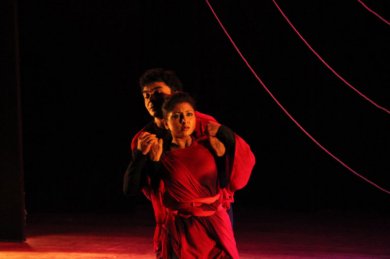
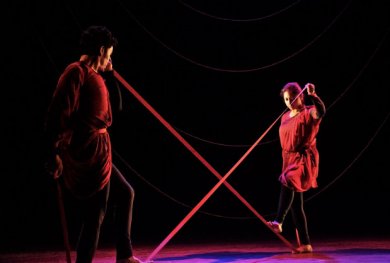
Vikram Iyengar was trained in classical Kathak by that doyen of Kathak, late Rani Karnaa from a young age. Today, Vikram is a name to reckon with in contemporary dance scene in India. His own institution Ranan is a centre where he with his team of dancers continues to explore the form and creates new works. Shunya Se is as per his choreographer's note a previous work which he has reworked in which instead of five elements (space-akash, vayu-air, agni-fire, jal-water, prithvi-earth), he has taken only three (space, fire and earth). The five elements resonate within the human body. From the most abstract and intangible, to the most concrete and tangible, all exist together, distinct yet closely connected. Shunya Se tries to discover and extend a reflection of this specificity and multiplicity and abstraction with and within the Kathak dance form and the Kathak informed body. The three sections explore Kathak in different ways. In the first section, dancers walk across the stage diagonally with no expressions on the face, to near silence to the mnemonic syllables of Kathak. There are movements similar to Kathak in minimal way. Fire shows movements which are more agitated to suggest fire. Two dancers are seen together; with use of a rope a dancer is pulled at one end of the stage. Two meet, embrace, move, separate and since it is section of fire, partly through music and visuals one gets the sense of fire. It is in prithvi, that Vikram uses foot work with variations, exploring rhythm, using light to focus on the feet of the dancers and also on the ankle bells. The audience familiar with traditional Kathak perhaps enjoys this aspect. However, the attempt on part of dancers and choreographer is to see how an all pervading pulse, a secret, sometimes silent rhythm that binds all this together - the elements of Kathak and the elemental universe - in a growing, morphing, evolving conversation created and spoken through the dancing body achieves its goal of communicating through abstraction. Vikram mentions that he wants to have a dialogue rather than a monologue in Kathak, his explorations aimed at his own re-imagined, re-invented Kathak's relevance to others' perceptions he can respond to for his continuous process of discovery. Performed against the black backdrop on which were hung series of ropes fastened to the rig, Shunya Se posed problems for audiences used to traditional Kathak presentation. The challenges Vikram and his dancers are posing are welcome for the contemporary dance scene in India. Day two featured Murchhana - the eternal spirit of music, a choreographic work in Odissi by Sharmila Biswas, disciple of Guru Kelucharan Mohapatra. Noted for her explorations of various talas and percussion instruments of Odisha, Sharmila Biswas has created a niche for herself. Sharmila shared with the audience that the journey of Murchhana began over 25 years ago. The study of mridang from where she found the concept of Murchhana was her first research project. She reinvented Murchhana several times, each time adding something more to the presentation. In the production staged at Tata Theatre, Sharmila used vachikabhinaya, telling the story particularly in English, so the metropolitan audiences can follow it and enjoy it. The use of English has become the norm as audiences from different walks of life attend the shows. While doing her research Sharmila met many mridang players who told her several stories. During the annual mridang making season the story of Murchhana is repeatedly told through the verses and songs as a part of mridang purification ritual. It is an oral tradition. 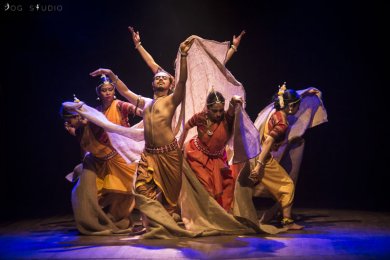
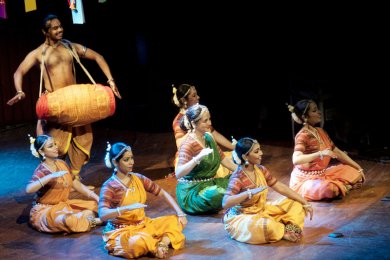
Sharmila has worked out three stories. The first one describes Rambha and Brahma discovering simple and primitive music in a newly born universe, and how Murchhana, the spirit, enters the music. The second story describes how music rises from passion and quest for everlasting youth. The gods sought eternal youth seeking nectar when churning the ocean. The narrative of Mohini, female form of Vishnu, is performed. Eternally young, passionate, each god creates Mohini Mridang and creates sangeet, whereby Murchhana re-enters the mridang and sangeet becomes transcended bliss. In the third story the music is given formal structure in the hands of Krishna, when he transforms the dead body of Tungavidya into mridang and dances in the Rasalila. Tungavidya was one Gopi who was not allowed to go to Krishna to join in Raas and she died. Krishna took her dead body and transformed it into mridang and Murchhana entered it. The Rasalila and the music enthralled the world. In one more story Sharmila has dealt with the story of Saint Chaitanya creating mridang for Naam Sankeertana, which alone is Murchhana's permanent abode in Naam Sankeertana mridang. Saint Chaitanya believed it is only through Naam Sankeertana that spiritual bliss is achieved. Sharmila changed the end with permission of the mridang guru Prahlad Baral. Besides Naam Sankeertana, she questioned and explored where else Murchanna is found. The music which is found in prayers, in boatman's song faring across sea, in mothers singing lullaby, and when artists get immersed in the music they create, where life and nature in any form are celebrated, Murchhana is found. A socially aware and sensitive artist, Sharmila conveys the message of the need for harmony between life and nature. What stands out in Sharmila's choreography, dancing, performing, enacting, and telling the story is its rustic spirituality, floating between real and make believe. She uses vachikabhinaya and simple gestures conveying all that is narrated above. The robust quality of Sharmila's dancers offers audience an opportunity of looking at another dimension of Odissi. There is rustic chanting also. The original voices of 'Paraja' tribe of Koraput are used in the scene of Rambha and Brahma, whereas in the sequence of Mohini, the musical pattern used is that of Odiya Bhagavata. The scenes moved from one to another in a seamless manner. The dancers were completely tuned to the ukutas, the bols of mridang. The variety of talas used gave it a special character and soundscape. The rhythm composition by Bijay Kumar Barik was lively. The music composition by Shrijan Chatterjee with Dukhishyam Tripathy captured the 'will o the wisp' quality of Murchhana. Collecting the lyrics, Sharmila worked on its communication quality. Where necessary she put correct Sanskrit text, its proper recitation to evoke the mood. There is an interesting use of chorus when dancers sit around Sharmila telling the story; they often replied to her in unison, or one speaks complementing the story. For design, Sharmila has on either side of stage colorful hangings on which she has placed envelopes containing stories. She plucks one by one and reads the story aloud. This helps in communicating the story. The sequences of Rasalila, in the finale the prayer, the boatman's singing of the song, mother's lullaby, lovers' union and artists completely immersing in dancing, achieves the rasanishapatti, the aesthetic relish. No wonder the dancers with their energetic and robust dancing brought down the house. Sharmila's team of dancers included Monami Nandi, Rohini Banerjee, Tri Paul, Krishnendu Saha, Riya Saha, and Debottama Sarkar. Odissi dancer Ramesh Jana executed Dinesh Poddar's design by lighting up the production imaginatively. Set design was by Nandagopal Jana. Lyrics were adapted from the original verses by Tamonash Chakravarty and Dukhishyam Tripathy. Sharmila's excellent team work has won her one more feather in her cap. 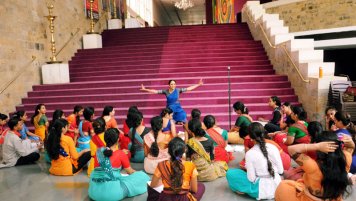
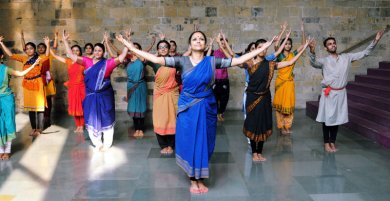
After Murchhana, Rama Vaidyanathan's Vivartana was scheduled by public demand. It received an enthusiastic response as many had missed it. Since it has been reviewed earlier, I would share with readers the workshop Rama had conducted for the young Bharatanatyam dancers. It was held in the foyer of Tata Theatre where Nataraja's statue is kept. The space is quite large and accommodated more than 35 dancers. The item chosen was Thiruvempavai Kavutuvam based on Tamil verses from the Thiruvempavai written by Manikkavachakar. Music in Ragamalika was composed by Sudha Raghuraman. Two verses from the work had been selected and arranged into a kavutuam format. I had seen the same composition earlier in Singapore at India Asia Pacific event during one of the sessions. Therefore attending the session for its entire duration was like learning a lot. More important was the process of transmission of technique and also explaining how to interpret it in abhinaya. Since the dancers had advance training in Bharatanatyam, it was not difficult to follow the nritta movements. Rama made the expressional aspects asking the dancers to follow what she was demonstrating, but after internalizing the meaning of the song, were asked to express them in various ways, keeping the main aspect intact, embellishing it with nuances. It validated the guru shishya parampara technique for young generation. What earlier dancers studied from their gurus was following whatever the gurus taught and there was little opportunity to ask questions. Today the disciples feel more free and relaxed to ask questions. For me to understand the Tamil composition and how Rama has turned it into a Kavutuam was interesting. I have attended workshops earlier by Kalanidhi Narayanan and also Kelubabu at NCPA. Such opportunities have helped me in sharpening my critical faculties. The question answer session was also very illuminating. 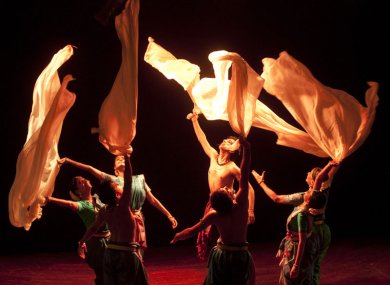
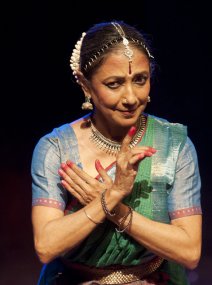
The third evening saw Leela Samson presenting her group choreography of Nadi with her Spanda group. It was a finished production with dancers executing Bharatanatyam movements in a flawless manner. Leela's solo carried the flow of the work in a seamless manner. A versatile dancer with vast experience, she invested the presentation with imagination coalescing poetry, music, dance and visual in arresting manner. Nadi is a selection of poems from six Indian languages - Tamil, Sanskrit, Kannada, Urdu, Hindi and Bengali - the compositions threaded together by composer Rajkumar Bharathi, who has retained some traditional tunes, and has recomposed others to attempt a dialogue between the past and present and between Carnatic and Hindustani music. Such a complex work translated into dance leaves one with admiration. Leela has used images while dancing on river Ganga - her recollections of how women used to spread yellow saris, how Ganga arati is performed, how women place little floating lamps in the waters, the sounds of 'Jay Jay Gange' et al create various images which anyone who has visited Ganga ghats would recall with nostalgia. Images overlap into Tagore's poem where Champakali speaks of 'ami achal' and intoxication of flowing river, and Dikshitar's exquisite Sanskrit poem. The thumri Ganga maiyya tohe pihari chadaive, kinare kinare... conjured up vision of boats; Girish Karnad's poem from Hayavadan had Rajkumar Bharati compose music using folk tunes, the finale giving impression of tillana and group performing joyously. Leela Samson's Nadi, a metaphor for life, multilingual, layered, rich and with Rajkumar Bharati's excellent music was highly enjoyable. 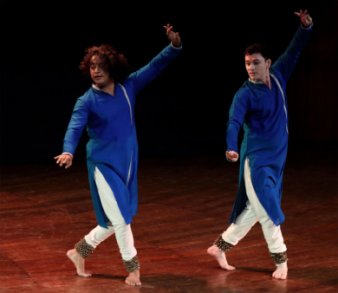
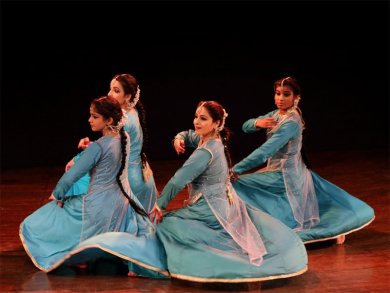
Rajendra Gangani, the renowned Kathak dancer of Jaipur gharana from Delhi presented his choreographic work Antarparva - A journey within. In today's times as we struggle to understand the outer world, it is the voice of the inner self that renders meaning to what we see. Rajendra Gangani has woven around this theme, the intricate patterns of Kathak and the mimetic exposition as a vessel of the voice of the inner self. The attempt to convey emotions that constantly collide with inner self and outer self is also suggested by the use of several poems which speak of these conflicts. For instance Rajasthani traditional song Ramaiyyo ghat mahe, B. Raghav's O Manava bavare, Mahadevi Verma's Ghor tam chhaya, Gurudev Nanak's Sumiran kar le mere manna, point at such emotions and one seeks solution in going unto sharan, seek refuge at the feet of the Lord. These are shared traditions and speak of Indian philosophy. Rajendra's own solo dance projecting some of these poems conveyed deep conviction as a mature dancer. The dancers consisted of his disciples Preeti Sharma, Deepti Gupta, Lipsa Narula, Kanchan Negi. The two male dancers Dheerendra Tiwari and Piyush Chauhan are well established dancers who were invited to participate in this production. The technical prowess of all these dancers is praiseworthy. In nritta, they excel with countless chakkars, flawless footwork and graceful movements. The music was recorded. Conceived and composed by Rajendra and assisted by Samiullah Khan for vocals, percussion by Yogesh Gangani, sarangi by Mohammad Ayyub and sitar by Khalid Mustafa had professional finesse. Dheerendra Tiwari and Neeraj Solanki had assisted in selection of the literary text. Since it was recorded it was under control. Else often with live music, the artists when warmed up get carried away and the time limit is also not observed. There was also what we call lot of 'sukun' - quiet, dignity and sobriety in overall presentation. The work appeared so integrated that one wondered it was over so soon. Rajendra Gangani showed that when he plans he can avoid all the negative points of Kathak. Also his abilities to work for a group production found a felicitous expression. 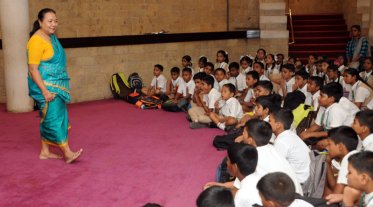
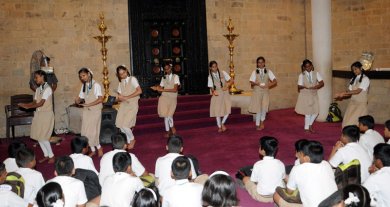
Workshop by Latasana Devi
Besides major events of Nakshatra Dance Festival, I also attended NCPA's outreach programs. Swapnokalpa, Director, Dance Division of NCPA, visualizes various outreach programs and those supported by Corporates under Corporate Social Responsibilities, and integrates with concurrent activities. She outlined 3 parts to community engagement activity. NCPA Nrityaparichay is a folk dance learning platform currently training over 400 children in Mumbai and greater Mumbai. NCPA Dance Outreach involves visiting schools and colleges with a 1 day or 2 days dance appreciation session on Indian classical dance. The NCPA Mumbai Dance Season is a month long celebration with talks, lec-dems, performances and workshops where NCPA collaborates with the dance community of Mumbai. 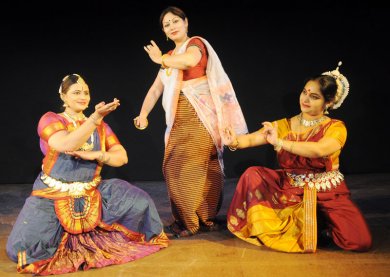 Purbita, Kshama, Swapnokalpa Swapnokalpa has an interesting story about how this started. “I had always felt that with the growing number of dance presentations in Mumbai we are increasingly eating into the audience number by programming good events on the same day. This clash of events can easily be avoided if we reach out and major dance organisers work as a team. So one day I just sent out whatsapp messages to all the major dance festival organisers I knew personally and asked if they would be happy to exchange dates so that when we programme we know what is happening where. At least if I know that a senior outstation Bharatanatyam artiste is coming to town I will not programme another one near that date. This way we would be able to attend more shows and all our shows in Mumbai would have good footfall. In case we have events that clash at least we will be cautious and may be have different dance styles on the same day happening in two festivals. This initiative was to look at Mumbai as a host... not just NCPA... not just one organisation or one individual. Together we build a better future which is mutually beneficial.”  Dr. Sunil Kothari is a dance historian, scholar, author and critic, Padma Shri awardee and fellow, Sangeet Natak Akademi. Dance Critics' Association, New York, has honoured him with Lifetime Achievement award. Post your comments Please provide your name and email id when you use the Anonymous profile in the blog to post a comment. All appropriate comments posted with name & email id in the blog will also be featured in the site. |